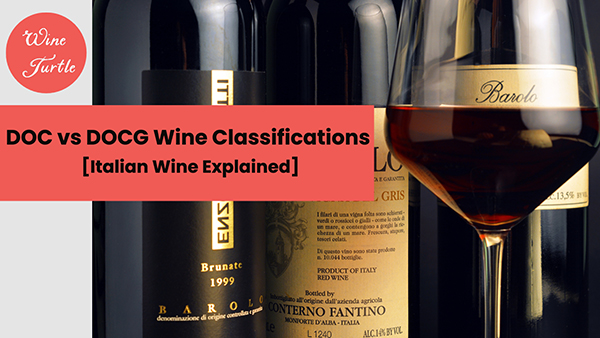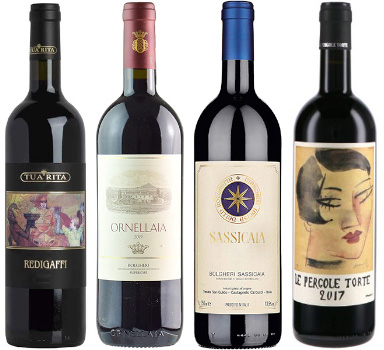DOC vs DOCG Wine Classifications [Italian Wine Explained]

Italy’s wine classification system is a regulatory structure that establishes the quality and geographic authenticity of its wines.
At the heart of this structure, you will find two significant designations: Denominazione di Origine Controllata (DOC) and Denominazione di Origine Controllata e Garantita (DOCG).
These classifications set specific rules for winemaking to ensure the wines bear a stamp of quality and heritage, though they have their unique nuances and significance.
In this guide, I compare DOC vs DOCG statuses to see what differences there are.
Characteristics of DOC and DOCG Wines
Geographical Indications
Both DOC and DOCG classifications have strict geographical designations.
This means wines bearing these labels must come from specific regions, sub-regions, or vineyards, as specified in their individual disciplinary guidelines.
The rules for DOCG wines are typically narrower, often confining production to a smaller, more precisely defined area than DOC wines.
Quality Standards
Quality is central to both classifications. However, DOCG represents the pinnacle of Italian wine quality, higher than the DOC.
While both DOC and DOCG wines must meet stringent standards, DOCG wines are subject to an additional level of scrutiny, including a tasting panel evaluation and chemical analysis to ensure the wines meet the highest quality standards.
Types of Wine
Both DOC and DOCG categories cover all types of wine – red, white, rosé, sparkling, and dessert wines.
The specific type of wine produced within each category is dictated by the disciplinary rules for that particular DOC or DOCG.
Production Processes and Methods
The production methods, including grape varietals used, yield limits, viticultural practices, and winemaking techniques, are stipulated for both DOC and DOCG wines.
The guidelines are usually more rigid for DOCG wines, aiming to preserve traditional methods and ensure a higher standard of quality.
Maximum Harvest Yields
Both classifications set a maximum limit on the amount of grapes that can be harvested per hectare. This ensures quality by preventing overproduction.
Typically, the yield limits are lower for DOCG wines, promoting a more concentrated, higher quality wine.
Labeling Requirements
DOCG wines require a numbered governmental seal on the neck of the bottle, serving as a guarantee of the wine's quality and authenticity.
While DOC wines also have specific labeling requirements, they do not require this seal.

What is the Difference Between DOC and DOCG Wines?
The primary difference between DOC and DOCG lies in the level of regulation and scrutiny applied.
While both classifications ensure the wines are regionally authentic and meet specific quality standards, DOCG wines are subjected to more stringent controls and quality checks, represented by the added 'G' for 'Garantita' (guaranteed).
This rigorous examination makes DOCG the highest classification for Italian wines.
The DOCG was actually introduced because it was thought that DOC status was being handed out too freely to wines. People were complaining that the quality was beginning to suffer, so in 1980, the first few DOCGs were introduced.
So what differences are there between DOC and DOCG status wines?
DOCG wines must meet the same criteria as DOC wines plus a few further caveats.
There are currently around 330 DOC wines and 77 DOCG wines. Tuscany has the most DOCG status wines. These include famous wines like Brunello di Montalcino and Chianti Classico.
What is DOC Wine Classification?
The Denominazione di Origine Controllata (DOC) classification was introduced in Italy in 1963 as part of a system to define the country's vast array of quality wines.
Modeled after the French Appellation d'Origine Contrôlée (AOC) system, the DOC classification aims to standardize wine production across the country, preserve traditional wine making methods, and promote these wines both domestically and internationally.
DOC rules stipulate the geographical area where the grapes can be grown, the types of grapes used, the maximum yield of grapes per hectare, the minimum alcohol content, the aging process, and other quality parameters.
The rules are intended to maintain the traditional wine characteristics of the specific region. In other words, the DOC classification serves to guarantee that a wine labeled as such meets the quality and style expectations of a wine from that region.
By the early 21st century, there were hundreds of DOCs scattered all over Italy, from the Alpine regions of the far north to the islands of Sicily and Sardinia in the south. Some DOCs are tiny, with only one or two producers, while others are vast areas that include many different styles of wine.
While the DOC classification signifies a certain level of quality, it's important to remember that not all DOC wines are created equal. There are always variations in quality and style between producers, vintages, and individual vineyards.
However, the DOC designation offers a good starting point for understanding and exploring the diverse world of Italian wines.
Examples of DOC Wines

What is DOCG Wine Classification?
The Denominazione di Origine Controllata e Garantita (DOCG) is the highest classification for Italian wines.
Introduced in 1980, it adds an extra layer of regulation to the DOC classification to guarantee the highest quality standards. The 'G' stands for 'Garantita', meaning 'guaranteed' - an additional promise of the wine's quality and authenticity.
Like DOC wines, DOCG wines must adhere to strict regulations defining the area of grape cultivation, the types of grapes used, the maximum yield of grapes per hectare, the minimum alcohol content, and the aging process.
However, DOCG rules are generally more rigorous, with strict testing, and a high level of quality on display when it comes to the growing of the grapes and the making of the wine.
Furthermore, each bottle of DOCG wine is subjected to a taste test by a panel from the government licensing body.
If the wine passes the test, it is granted a numbered government seal, which is placed around the neck of the bottle. This seal is a mark of quality assurance, serving as a guarantee to consumers that the wine inside the bottle meets the highest standard
Examples of DOCG Wines

